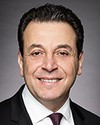Mr. Speaker, when the Liberals originally introduced this new system of tax breaks, they promised it would be revenue neutral. Shortly after taking office, however, they abandoned this promise. It is projected by the parliamentary budget officer that Bill C-2's changes will cost Canadians $8.9 billion over the next six years.
This gross miscalculation speaks to the government's incompetence, and the fact that the Liberals are proceeding with this legislation after admitting they have broken this promise to Canadians speaks to their integrity.
In fact, many of the government commitments seem to be falling by the wayside: a $10-billion deficit cap, consultation with opposition, openness and transparency. That is three months and three major broken promises. So much for sunny ways.
This leads to a lack of trust in the government's future plans. There is a lack of transparency with this promise. Who knows how much higher these costs will go? There is a lack of evidence or explanation for why Bill C-2's changes would stimulate economic growth and development for Canadians.
Tax breaks for the middle class are not, in themselves, sufficient to stimulate economic growth and development. It is, therefore, quite likely that more initiatives will have to be introduced.
These will require even more money from the government. This money will either have to be drawn from reduced spending on public services or from the taxpayer base. Given the vulnerable economic state of Canada, tapping further into government revenue is particularly risky for this country as a whole, and also for individual Canadians.
The government continues to move ahead with these types of long-term commitments, even amidst a struggling economy, a weakening dollar, and plummeting oil prices. Canadians are asking how much higher the cost will go. These kinds of commitments are one more chip into creating long-term structural deficits, and in turn they discourage investment and growth in a struggling economy.
Our Conservative government worked very hard every day in office to stretch every cent. We left the government a surplus and expected that to be spent with caution. It seems that work was all for nothing.
The Liberals continue signalling that they plan to run massive, long-term structural deficits, which will increase the burden on taxpayers and leave Canada more vulnerable to sudden economic shocks. Our Conservative caucus will continue to stand up for taxpayers, and press the government to approach spending in a responsible manner, to protect against risk, to ensure stability and long-term prosperity.
On the subject of changes to the tax-free savings account, all Canadians over 18 may contribute to TFSAs for all purposes, not just education and retirement savings. This makes the savings mechanism the most flexible way for all to save. It is because of this that many Canadians of all backgrounds have come to rely on the tax-free savings accounts.
We have heard from students saving for higher education, families saving to start a family, entrepreneurs saving for their businesses, parents saving for their children, and low-income seniors saving for retirement, all of whom are investing in TFSAs.
It is Canadians of all kinds of financial backgrounds too. The majority of TFSA accounts belong to low- and middle-income earners. The fact is that two-thirds of TFSAs are held by tax filers with incomes less than $60,000.
What kind of message is the government projecting when it is taking away the ability for Canadians to save for their future, while racking up massive deficits?
Why does the government continue down the path of a nanny-state approach, limiting choice for Canadians to save their own money?
These are not mandatory contributions. In contrast, the Ontario Liberal plan for a provincial pension plan is. If the argument is that very few Canadians have the ability to afford a maximum contribution, why is the member opposite so opposed to offering that choice, while in other instances forcing it upon others?
Personal fiscal responsibility is something that our government should be encouraging, regardless if it refuses to lead by example.
We are in uncertain times, with dropping commodity prices, a dipping dollar, and slowing economic growth.
Recently, the PBO released a report on the state of household indebtedness and financial vulnerability in Canadians, showing that household debt-servicing capacity continues to trend upward, while capacity to meet debt obligations diminishes.
Households now face overwhelming exposure to negative income and interest rates, and are more likely to become delinquent in debt payments.
Responsible Canadians are looking for a way to save when times are good, so they can be protected. Reducing TFSA contribution limits would reduce the abilities of real Canadians to save for retirement and to protect themselves from economic shock.
This would translate to a greater burden upon all taxpayers to support those who will be unable to support themselves. Why is the government hiding these future costs from its taxpayers?
In contrast to Liberal deficit spending, whose purposes are unclear, TFSAs provide a concrete vehicle for financial independence for Canadians. Instead of encouraging consumption, they encourage saving—promoting independent control over funds—which shields Canadians from economic shock.
The burden of economic shocks on vulnerable Canadians will ultimately fall on the overall taxpaying base if the government must step in and support these individuals. Money will come from taxpayers, or public services will be compromised for the expense of increased government financial support.
TFSAs remove barriers for all Canadians to maximize their financial positions. TFSAs are open to all Canadians over 18 years of age with valid social insurance numbers. They are simple and accessible. Anyone can contribute any amount. They encourage financial literacy and curiosity.
In fact, the majority of TFSA accounts belong to low- and middle-income earners. TFSAs allow investments—any sort of investment—deposited into them to grow tax free. TFSAs make retirement savings more accessible, simple, and compelling. If individuals do not save enough for retirement, all taxpaying Canadians will ultimately be responsible for the burden.
The government's spending plans, including its nebulous deficits, are risky. We have seen no concrete evidence for targeted growth plans. Savings will shield vulnerable Canadians from the risks involved.
Conversely, limiting savings tools will limit economic self-protection and make Canadians more economically dependent upon the government. This is dangerous, given the lack of clear economic plans and directions from the government. Government dependence will likely translate to higher taxes for Canadians across a wide socioeconomic spectrum.
In popular debate, the media, and academic research, a brain drain out of Canada is cited as a very real possibility. Most doctors, lawyers, and other skilled professionals are found in the upper tax bracket, and their departure could be very dangerous for Canada.
Progressive taxation reduces investment, risk-taking, and entrepreneurial activities, since a large share of these activities is done by high-income earners.
The substitution effect is a principle that essentially states, “I'm getting less money for each hour I work; therefore, I should work fewer hours”.
Tax avoidance activities such as reporting less income, using tax-planning techniques to reduce the tax burden, working fewer hours, or even not seeking job promotions are very real possibilities.
Progressive income taxes reduce the returns to education, since high incomes are associated with high levels of education. They reduce incentives to build human capital, the kind of investment the Prime Minister talked about in Davos, while turning his back on our resources sector.
Academic consensus among experts is that taxes on both corporate and personal income are particularly harmful to economic growth, as economic growth ultimately comes from production, innovation, and risk-taking.
The conclusion is that tax rates of over 50% will not raise revenue. Between provincial and federal income taxes for top income earners, this is what would happen under Bill C-2.
I will not support Bill C-2.









